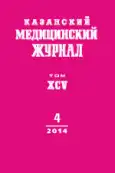Оценка риска ущерба для здоровья при воздействии мелкодисперсной пыли минеральной ваты
- Авторы: Копытенкова О.И.1, Леванчук А.В.1, Турсунов З.Ш.1
-
Учреждения:
- Петербургский государственный университет путей сообщения Императора Александра I, г. Санкт-Петербург
- Выпуск: Том 95, № 4 (2014)
- Страницы: 570-574
- Тип: Гигиена труда
- URL: https://journals.rcsi.science/kazanmedj/article/view/1846
- DOI: https://doi.org/10.17816/KMJ1846
- ID: 1846
Цитировать
Полный текст
Аннотация
Ключевые слова
Полный текст
Открыть статью на сайте журналаОб авторах
Ольга Ивановна Копытенкова
Петербургский государственный университет путей сообщения Императора Александра I, г. Санкт-Петербург
Александр Владимирович Леванчук
Петербургский государственный университет путей сообщения Императора Александра I, г. Санкт-Петербург
Закир Шухратович Турсунов
Петербургский государственный университет путей сообщения Императора Александра I, г. Санкт-Петербург
Email: tursunov_zokirjon@mail.ru
Список литературы
- Земцов А.Н., Николаева И.Л. Строительная теплоизоляция и энергосбережение // Стены и фасады. - 2001. - №5-6. - С. 32-36.
- Зеркалов Д.В. Безопасность труда в сфере охраны здоровья. Правила. Рекомендации. Инструкции. Справочное пособие. - К.: Основа, 2011. - 598 с.
- Измеров Н.Ф. Концепция долгосрочного социально-экономического развития Российской Федерации на период до 2020 г. («Стратегия 2020») и сохранение здоровья работающего населения России // Мед. труда и промышл. экология. - 2012. - №3. - С. 1-8.
- Минеральная вата - свойства и характеристики [Электронный ресурс] // Портал строительные материалы и оборудования. - 2011. - http://www.rmnt.ru/story/isolation/351113.htm (дата обращения: 18.03.2012).
- Burnett R.T., Cakmak S., Brook J.R., Krewski D. The role of particulate size and chemistry in the association between summertime ambient air pollution and hospitalization for cardiorespiratory disease // Environ. Health Perspect. - 1997. - Vol. 105, N 6. - P. 614-620.
- Navas-Acien A., Selvin E., Sharrett A.R. et al. Lead, cadmium, smoking, and increased risk of peripheral arterial disease // Circulation. - 2004. - Vol. 109, N 25. - P. 3196-3201.
- Pope C.A. Epidemiology of fine particulate air pollution and human health: biologic mechanisms and who’s at risk? // Environmental Health Perspectives. - 2000. - Vol. 108, suppl. 4. - P. 713-723.
Дополнительные файлы






